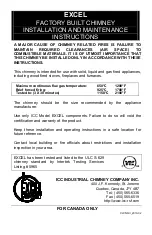
NOTE: DIAGRAMS & ILLUSTRATION ARE NOT TO SCALE.
8
Consult all local codes.
Properly size and route the gas supply line
from the supply regulator to the area where the
appliance is to be installed per requirements
outlined in the National Fuel Gas Code, NFPA
54 - latest edition (USA) or B149 - latest edition
(Canada). Never use galvanized or plastic pipe.
Gas lines must be routed, constructed and made
of materials that are in strict accordance with
local codes and regulations. We recommend
that a qualified individual such as a plumber
or gas fitter be hired to correctly size and route
the gas supply line to the appliance. Installing
a gas supply line from the fuel supply to the
appliance involves numerous considerations of
materials, protection, sizing, locations, controls,
pressure, sediment, and more. Certainly no one
unfamiliar and unqualified should attempt sizing
or installing gas piping.
Remove the gas line access cover plate on either
the left or right side of the fireplace (see Figure
7 showing locations).
Install 1/2" min. to 1-1/2" max. inside diameter
approved gas line through the firebox wall for
connection to the Vent-Free room heater inside
the firebox. Connect the gas line before the
firebox is enclosed in the finished wall. Gas line
holes and other openings should be caulked with
high temperature caulk or stuffed with unfaced
fiberglass insulation.
Ensure that a sediment trap is installed in the
existing gas line, if not, install a sediment trap
upstream of the heater to prevent moisture and
contaminants from passing through trap to the
heater controls and burners. Failure to do so
could prevent the heater from operating reliably.
An external regulator must be used on all pro-
pane (L.P.G). heaters, in addition to the regulator
fitted to the heater, to reduce the supply tank
pressure to 13" W.C. (maximum). Any copper
tubing used to supply propane (L.P.G). from
the tank must be internally tinned.
INSTALLATION
Gas Line Installation
ASSEMBLY STEPS
NOTES:
• Illustrations shown in this manual reflect
“typical” installations with nominal dimen-
sions and are for design and framing refer-
ence only. Actual installations may vary due
to individual design preferences. However,
always maintain minimum clearances to
combustible materials and do not violate any
specific installation requirements. Refer to
the Framing Specifications Figures 8 through
10 on Page 11.
• The following steps represent the normal
sequence of installation. Each installation
is unique, however, and might require a
different sequence.
Step 1. Position firebox prior to framing or
into prepared framing.
Step 2. Field wire the main power supply to
the appliance if a blower kit is to be installed
(at the time of installation or a later date).
An optional junction box kit and blower kit is re-
quired (see Page 15 for ordering information).
Follow the installation and wiring instructions on
Pages 12 through 14). Electrical connections
should only be performed by an experienced,
licensed/certified tradesman.
Step 3. Plumb gas line. (Gas connections
should only be performed by an experienced,
licensed/certified tradesman).
Step 4. Install decorative type Vent-Free room
heater per the instructions provided with the
Vent-Free room heater.
Step 5. Complete finish wall material, sur-
round and optional hearth extension to your
individual taste.
TEST ALL CONNECTIONS FOR GAS LEAKS
(FACTORY AND FIELD)
Test all gas joints from the gas meter to the gas
heater regulator for leaks using a gas leak test
solution (also referred to as bubble leak solution).
NOTE: Using a soapy water solution as a leak
detection solution is not recommended because
the soap residue that is left on the pipes/fittings
can result in a false-positive leak detection reading
if a gas leak sniffer is used. Soap residue can also
result in corrosion over time.
DO NOT USE AN OPEN FLAME TO CHECK
FOR LEAKS.
Leak Test Procedure:
Turn on gas supply and test for gas leaks using
a gas leak test solution.
A. Light the appliance (refer to the lighting
instructions label provided with gas logs).
B. Brush all joints and connections with the gas
leak detection solution. If bubbles are formed,
or gas odor is detected, turn the gas control
knob (off/pilot/on) to the “OFF” position. Either
tighten or refasten the leaking connection, then
retest as described above.
C. When the gas lines are tested and found to
be leak free, rinse off the leak testing solution
from gas line fittings.
WARNING
Connecting directly to an unregu-
lated propane (L.P.G.) tank can
cause an explosion.
CAUTION
Plumbing connections should
only be performed by a qualified,
licensed plumber. Main gas supply
must be off when plumbing gas line
to fireplace or performing service.
IMPORTANT
Hold heater regulator with a wrench
to prevent movement when connect-
ing to inlet piping.
WARNING
Check Gas Type: The gas supply
must be the same as stated on the
heater’s rating plate. If the gas
supply is different, DO NOT INSTALL
the heater. Contact your dealer for
the correct model.
IMPORTANT
Pack unfaced fiberglass insulation
material (not provided) around the
gas line access hole on appliance
and all exterior gas line penetra-
tion holes.






































